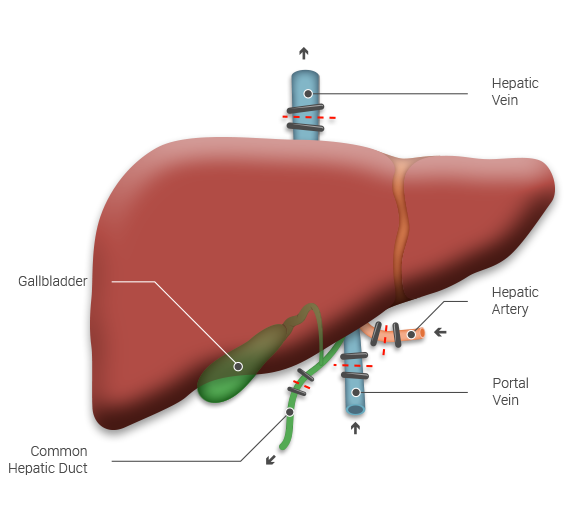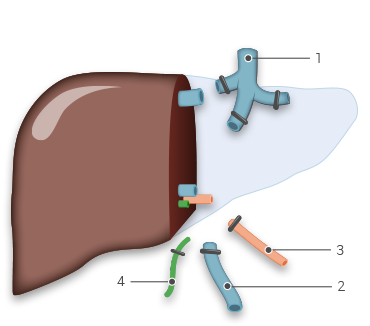

Incision
Your skin will be disinfected, and the surgeon team will begin by making a large incision on your abdomen. It will run along the bottom edge of the ribcage, and sometimes up your midline if necessary, giving it the shape of an upside-down Y. Most of your liver is underneath your ribs, so this incision will provide access to the liver from below.

Liver Removal
The surgeon team will interrupt blood-flow to your diseased liver by clamping down all vessels. This process is known as ligation. Once ligated, they will cut the vessels along the dotted red lines. They will also sever all connective tissue (tendons, cartilage, etc.) holding your liver in place. Once safely released from all vessels and tendons connecting it to the body, the liver will be removed from your body and disposed.
New Liver Implantation

If you’re receiving a deceased donor liver, you'll get a whole new liver. The surgeon team will reattach your blood vessels to the liver’s vessels in the following order:
The ligations previously placed will be removed to restore blood-flow into the donated liver, where some bleeding is expected and controlled. The doctors will ensure proper blood-flow before reconnecting the bile duct.
If you are small, there is a chance you’ll receive a “split liver” transplant; in this case the donor’s liver will be split into two segments. This way two people may get the benefit of the transplant.

If you're receiving a living donor liver, you'll get only a portion of the donor's liver. Click here to learn about the living donor surgery. For adults, this is usually the right lobe, which makes up ~60% of the donor’s liver. If the recipient is a child, he or she will likely receive the smaller left lobe, which makes up ~30% of an adult’s liver volume. The surgeon team will reattach the following vessels:
The clamps (ligations) will be removed to restore blood-flow into the new liver, where some bleeding is expected. After the bleeding is controlled, they will reconnect the bile duct. The transplanted lobe is expected to regenerate to 100% volume according to the recipient’s size over the upcoming months.

Gallbladder
The gallbladder stores bile that's produced by the liver until it's needed for digestion. Your gallbladder will be permanently removed during the transplant surgery to avoid complications that may require a secondary surgery. Some of these complications may include biliar leakage, or gallstones. Having no gallbladder has a very small impact on your digestive function, so the benefits outweigh the disadvantages.

Potential Bleeding
The liver has many blood vessels running through it. It holds about 15% of the blood in your body, and receives ~25% of your heart's output. Despite the surgeons’ best efforts to avoid it, bleeding is always expected during a surgery of this type. This is why we always bring several units of blood into the operating room to substitute the missing blood as necessary. If you’re healthy enough, this blood will come from you, the recipient. We’ll withdraw and store the necessary blood over a period of several days before the surgery.

Finishing Steps
Your surgeon will place three drains in the area surrounding your new liver. These are called Jackson-Pratt drains and they are necessary to draw excess fluids away from your liver. (Learn more on Jackson-Pratts in the Postoperative Care section). The team will close the incision with staples; the anesthesiologist team will take you off general anesthesia; and you’ll be transferred to the PACU for close observation as you slowly wake up. The entire surgery is expected to last from four to fifteen hours, depending on the complexity of the transplant that’s being performed.